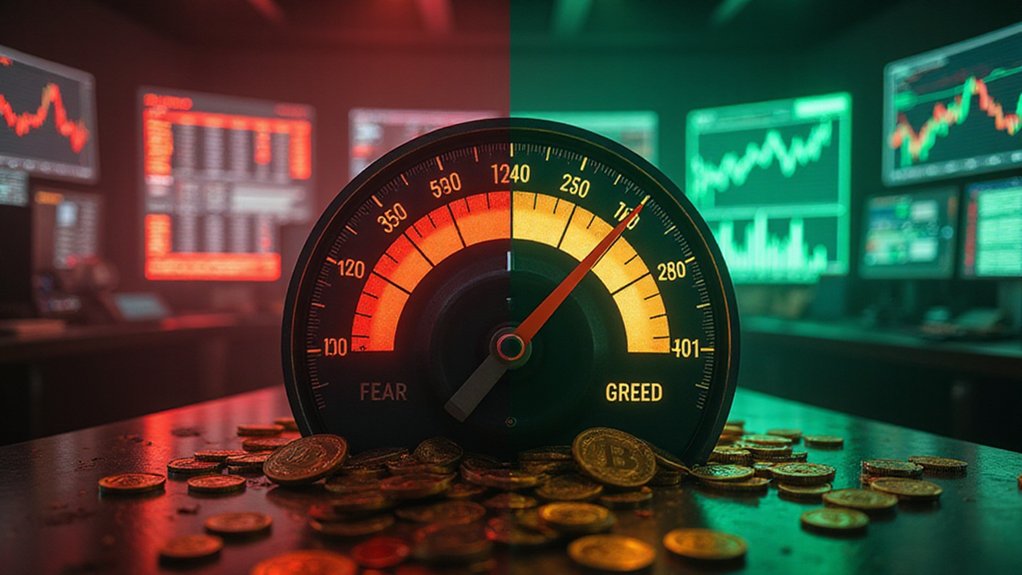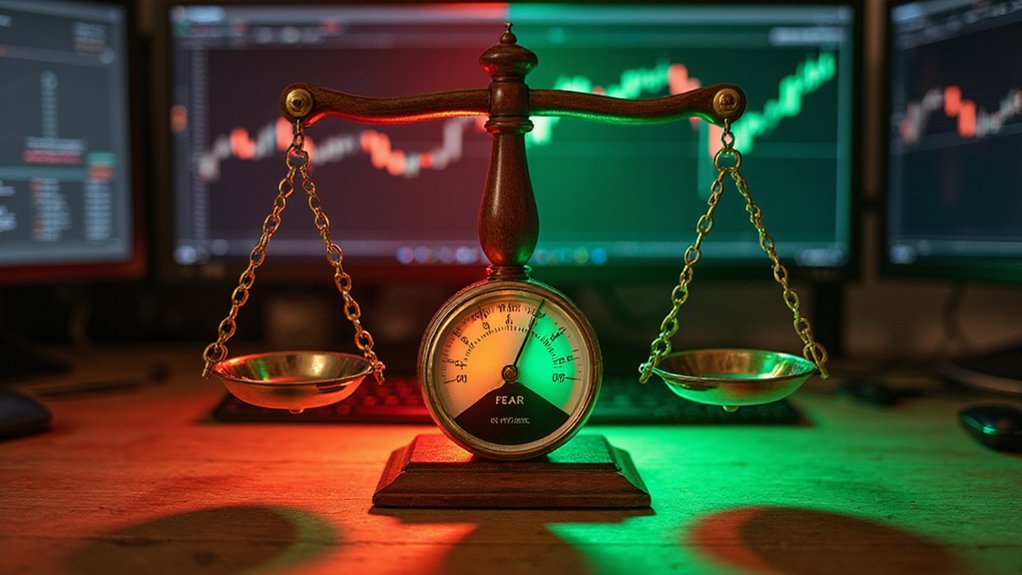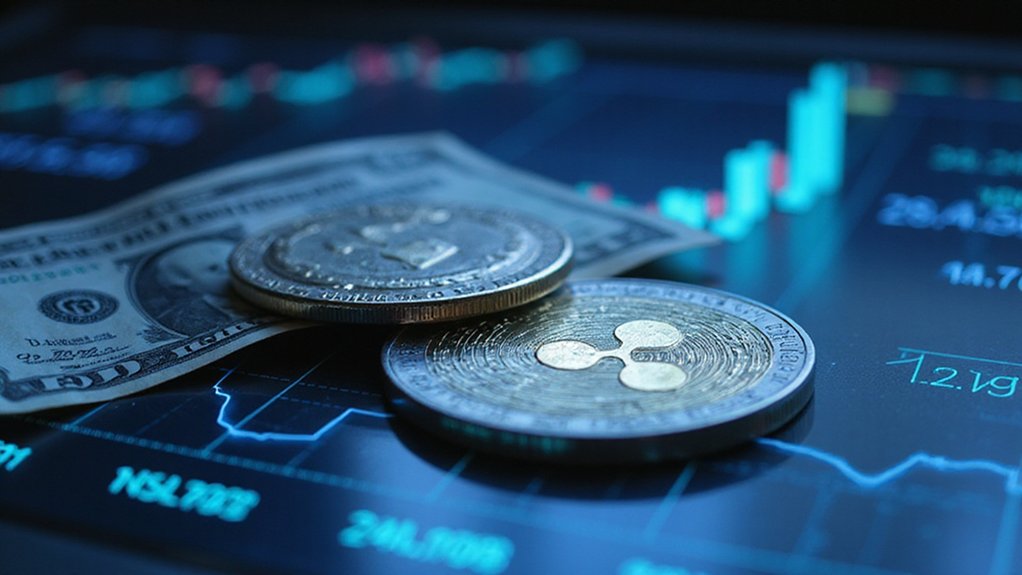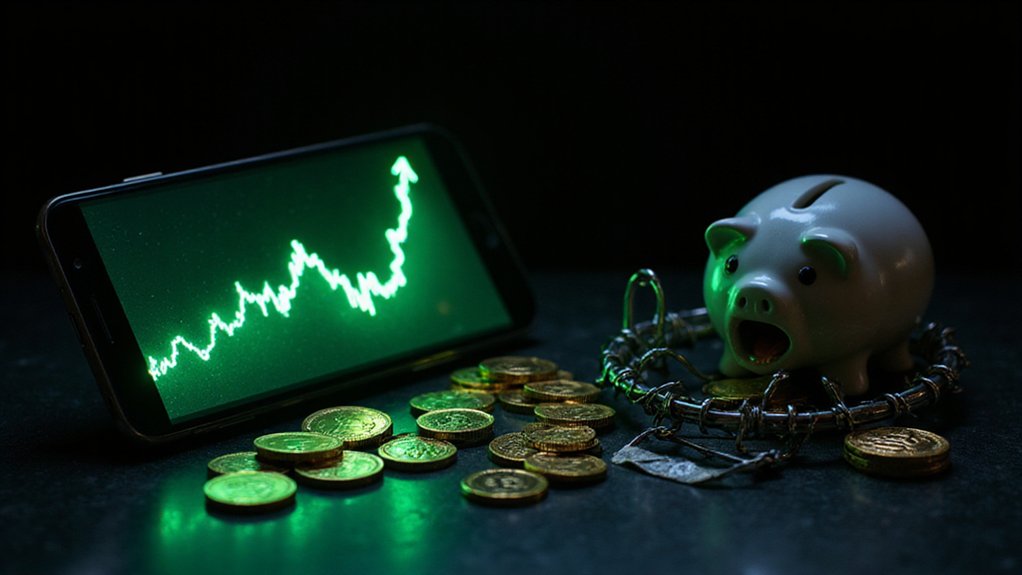The Fear and Greed Index functions as Wall Street’s emotional thermometer, measuring market sentiment on a scale from 0 (extreme fear) to 100 (unbridled greed). Composed of seven distinct indicators—including market momentum, stock price strength, and options activity—this barometer helps investors identify when emotions have divorced from fundamentals. Historical extremes (12 during the 2008 crisis, 2 during the pandemic) often signal potential market inflection points. Contrarians find particular value in these sentiment extremes.

The Fear and Greed Index, developed by CNN Business as a sophisticated barometer of market psychology, serves as a numerical representation of the collective emotional state driving financial markets at any given moment. Operating on a scale from 0 to 100—where 0 represents paralyzing fear and 100 indicates unbridled avarice—this metric distills complex market behaviors into a single, digestible figure that reveals whether stocks are potentially under or overvalued based on prevailing sentiment rather than fundamentals.
The index’s calculation methodology incorporates seven distinct indicators, each measuring a specific dimension of market behavior. These equally weighted metrics include market momentum (comparing the S&P 500 against its 125-day moving average), stock price strength (the ratio of 52-week highs versus lows on the NYSE), and stock price breadth (advancing versus declining volume). The index also considers the put and call options ratio as a crucial signal that indicates fear or greed levels among market participants. Additional factors typically encompass volatility measurements, safe haven demand, trading volumes, and options activity—creating a thorough picture of investor psychology that transcends any single market metric.
Historical extreme readings have coincided with significant market events—the 2008 financial crisis saw the index plummet to 12, while the pandemic-induced market collapse of 2020 drove it to an almost inconceivable 2. Such extremes often signal potential inflection points; when fear reaches its zenith, bargains abound for those with the fortitude to act contrary to prevailing sentiment (and vice versa when greed dominates). Market exchanges often utilize the index to predict trading volumes during periods of extreme fear, allowing them to prepare for potential volatility. Understanding how market manipulation tactics like FUD contribute to these fear-driven market conditions can help investors distinguish between genuine market concerns and artificially created panic.
Prudent investors recognize the index as one tool among many, not a standalone crystal ball. Its value lies in identifying moments when emotion, rather than rational analysis, drives market behavior. The index elegantly captures the perpetual market pendulum—oscillating between irrational exuberance and unwarranted pessimism—that creates opportunities for the disciplined investor. Who recognizes that markets, like pendulums, invariably overcorrect before finding equilibrium. Essentially, it quantifies Baron Rothschild’s timeless wisdom: the ideal time to buy is when blood runs in the streets, even if some of that blood is your own.
Frequently Asked Questions
How Often Is the Fear and Greed Index Updated?
The Fear and Greed Index is updated regularly, drawing on real-time market data and recent historical trends to reflect current investor sentiment.
While the exact intervals aren’t explicitly detailed in the background information, the index maintains relevance by incorporating fresh data points from its seven equally-weighted indicators.
This continuous updating guarantees the index serves as a timely barometer of market psychology—a thermometer, if you will, measuring the fever pitch of investor emotions.
Who Created the Original Fear and Greed Index?
The original Fear and Greed Index was developed by CNN Business as a tool for measuring stock market sentiment.
This innovative metric, designed to quantify the emotional drivers behind market movements, emerged from the recognition that investor psychology often trumps fundamentals in short-term price action.
Can the Index Predict Market Crashes Accurately?
The index cannot predict market crashes accurately.
It particularly functions as a lagging rather than leading indicator, often registering extreme fear only after significant downturns have occurred (as evidenced during both 2008 and 2020 crashes).
While extreme readings may coincide with market turning points, the correlation lacks predictive specificity.
Without fundamental economic data integration or forward-looking components, the index merely reflects current sentiment—capturing the emotional temperature after the financial fever has already broken.
How Do Professional Traders Use This Index?
Professional traders utilize the Fear and Greed Index as a contrarian timing mechanism, not as a standalone tool but rather integrated within broader analytical frameworks.
They judiciously assess extreme readings—buying when fear paralyzes markets and trimming positions when greed runs rampant.
The savviest practitioners incorporate the index for portfolio rebalancing, risk calibration, and position sizing adjustments, particularly during sentiment extremes when irrational market psychology creates asymmetric opportunities for those disciplined enough to fade the emotional consensus.
Are There Fear and Greed Indices for Cryptocurrencies?
Yes, cryptocurrency-specific Fear and Greed indices exist and thrive in abundance.
These specialized sentiment barometers—updated in real-time—are offered by major platforms including CoinMarketCap, Binance, Alternative.me, and CryptoRank.
Each tracks the peculiar emotional rollercoaster of crypto markets through tailored metrics like volatility, trading volume, social media sentiment, dominance patterns, and search trends.
The indices function identically to traditional market counterparts, mapping sentiment from extreme fear (0) to extreme greed (100), though with variables uniquely calibrated for digital asset psychology.









